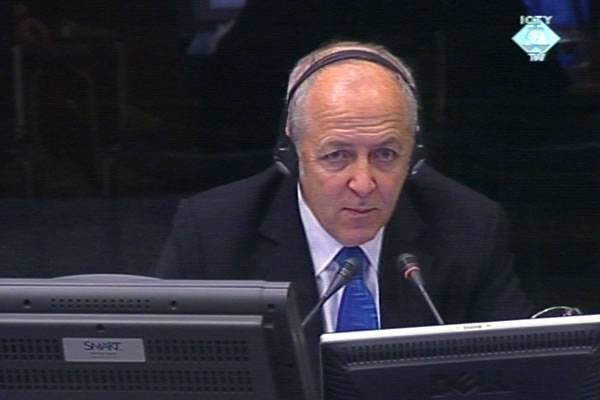Home
ETHNIC CLEANSING AND HEARTLESS DAY IN SARAJEVO
Testifying at the trial of Radovan Karadzic, British journalist Jeremy Bowen described how the pattern of ethnic cleansing in the Bosnian Serb controlled areas in BH became ‘institutionalized’. Bowen also described the day in the course of the siege of Sarajevo in which two children, wards of the Ljubica Ivezic orphanage, were killed
 Jeremy Bowen, witness at the Radovan Karadzic trial
Jeremy Bowen, witness at the Radovan Karadzic trial Ethnic cleansing was the main feature of the wars in the Balkans, said Jeremy Bowen, BBC war reporter, in his evidence at the trial of former Republika Srpska president Radovan Karadzic. Bowen noted that all sides did ethnic cleansing, but the Bosnian Serbs led the way. They committed ‘incredible sorts of atrocities’ against civilians, Bowen said.
In the examination-in chief, prosecutor Carolyn Edgerton brought up the witness’s war reports from the beginning of the war in BH, showing thousands of expelled Muslims en route from Bosanski Petrovac towards Travnik. According to what some eyewitnesses claimed, some of the victims had been shot brutally on their doorstep in retaliation for the battlefield losses. Others, as seen in the footage, left their homes with bundles in their hands undercover of the night.
As time went by, ethnic cleansing became ‘institutionalized’ and ‘an everyday activity’ of the local Serb officials, Bowen said. A BBC report from Bijeljina was shown to illustrate the point. In the report, a local Serb official, Vojkan Djurkovic, called himself the president of the Regional Committee for the Freedom of Movement and claimed he was a ‘social worker’, whereas in actual fact, as Bowen said, Djurkovic was in charge of ethnic cleansing.
According to the witness, Serbs used the siege of Sarajevo as a weapon as much as it used bullets and mortar shells: it was a means to put political pressure on the Bosnian government. ‘It was a kind of a noose around the people’s necks that could be tightened and loosened periodically’, Bowen said. The desperation among the city residents increased with time, the sidewalks were pockmarked with craters and people didn’t know where the next shell would fall, the witness recounted. ‘There was neither time nor place where people could feel safe’, Bowen said.
The prosecution showed a BBC report about the killing of two-year old Vedrana Glavas and Roki Sulejmanovic, who was a few months younger than her. The children were killed when fire was opened on a bus full of children from the Ljubica Ivezic orphanage on 1 August 1992. ‘It was a very cruel day, a heartless day’, the British journalist said. Reporting on the incident, Bowen said that shots had been fired from Serb positions. In the report, Bowen said that fatal fire was opened from the Oslobodjenje building, but today in court, he corrected himself, saying that at the time he didn’t know Sarajevo very well.
In the examination-in-chief, the prosecutor exhibited Bowen’s reports from besieged Gorazde in August 1992, from Cerska that fell into Serb hands in February 1993, and his reports about the fall of Srebrenica in July 1995.
At the beginning of his cross-examination, Radovan Karadzic claimed that the witness’s reports were based on disinformation disseminated to the journalists by the Bosniak side in order to ‘vilify’ Serbs. Karadzic tried to prove it with the example of two Sarajevo children who were killed, putting it to the witness that the shots that killed them were fired from the ‘Muslim positions’.
The witness dismissed such claims, adding that when the bus was hit it had already left the territory controlled by the Bosnian side. The Serb argument that Muslims were shelling their own people during the war has never been proven in any way over the past years, the witness insisted.
Karadzic will continue his cross-examination of the British journalist tomorrow.
Linked Reports
- Case : Karadzic
- 2011-01-12 KARADZIC’S MOTION DISMISSED
- 2010-12-16 KARADZIC NOT CONVINCED ABOUT AUTHENTICITY OF PROSTHETIC LIMB FROM MARKALE
- 2010-12-15 WHO DENIGRATED RADOVAN KARADZIC
- 2011-01-14 KARADZIC: ‘SARAJEVO WAS BESIEGED FROM THE INSIDE’
- 2011-01-17 KARADZIC ASKS FOR ANOTHER THREE-MONTH BREAK
- 2011-01-18 ‘PROFITABLE TARGETS’ OF THE SERB ARTILLERY
